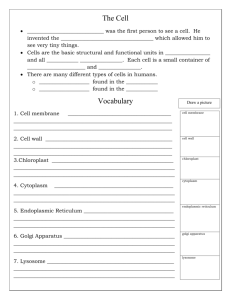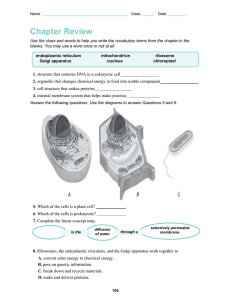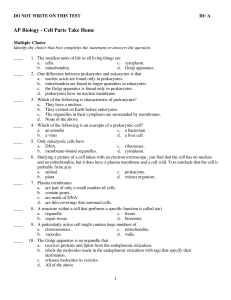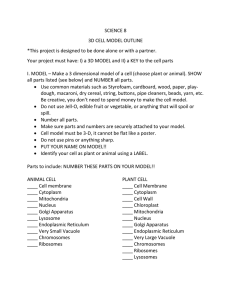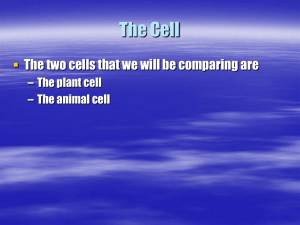Cells Quiz
advertisement
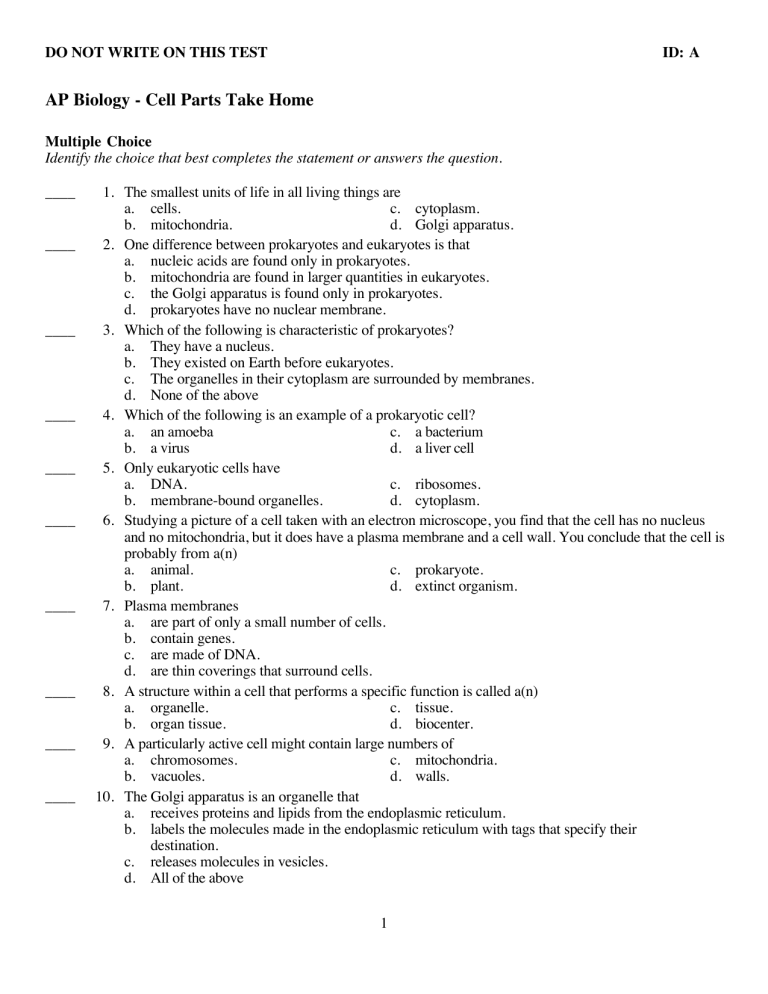
DO NOT WRITE ON THIS TEST ID: A AP Biology - Cell Parts Take Home Multiple Choice Identify the choice that best completes the statement or answers the question. ____ ____ ____ ____ ____ ____ ____ ____ ____ ____ 1. The smallest units of life in all living things are a. cells. c. cytoplasm. b. mitochondria. d. Golgi apparatus. 2. One difference between prokaryotes and eukaryotes is that a. nucleic acids are found only in prokaryotes. b. mitochondria are found in larger quantities in eukaryotes. c. the Golgi apparatus is found only in prokaryotes. d. prokaryotes have no nuclear membrane. 3. Which of the following is characteristic of prokaryotes? a. They have a nucleus. b. They existed on Earth before eukaryotes. c. The organelles in their cytoplasm are surrounded by membranes. d. None of the above 4. Which of the following is an example of a prokaryotic cell? a. an amoeba c. a bacterium b. a virus d. a liver cell 5. Only eukaryotic cells have a. DNA. c. ribosomes. b. membrane-bound organelles. d. cytoplasm. 6. Studying a picture of a cell taken with an electron microscope, you find that the cell has no nucleus and no mitochondria, but it does have a plasma membrane and a cell wall. You conclude that the cell is probably from a(n) a. animal. c. prokaryote. b. plant. d. extinct organism. 7. Plasma membranes a. are part of only a small number of cells. b. contain genes. c. are made of DNA. d. are thin coverings that surround cells. 8. A structure within a cell that performs a specific function is called a(n) a. organelle. c. tissue. b. organ tissue. d. biocenter. 9. A particularly active cell might contain large numbers of a. chromosomes. c. mitochondria. b. vacuoles. d. walls. 10. The Golgi apparatus is an organelle that a. receives proteins and lipids from the endoplasmic reticulum. b. labels the molecules made in the endoplasmic reticulum with tags that specify their destination. c. releases molecules in vesicles. d. All of the above 1 ID: A ____ ____ ____ ____ ____ ____ ____ ____ ____ ____ 11. In which of the following organelles is a cell’s ATP produced? a. mitochondrion c. Golgi apparatus b. endoplasmic reticulum d. lysosome 12. Proteins are made on the a. mitochondria. c. nucleus. b. ribosomes. d. plasma membrane. 13. The packaging and distribution center of the cell is the a. nucleus. c. central vacuole. b. Golgi apparatus. d. nuclear envelope. 14. The double membrane surrounding the nucleus is called the a. nucleolus. c. nucleoplasm. b. nuclear wall. d. nuclear envelope. 15. All cells have a. a covering called a plasma membrane that surrounds the cell and controls what information and materials enter and leave it. b. an internal fluid that gives shape to the cell and supports the other things within it. c. either a central zone or a nucleus that contains the cell’s genes. d. All of the above 16. All of the following are found in both plant and animal cells, except a. a cell wall. c. mitochondria. b. a plasma membrane. d. the endoplasmic reticulum. 17. How are chloroplasts like mitochondria? a. They can both use energy from sunlight. b. They look alike. c. They both contain DNA. d. They are both found in animal cells. 18. The organelles associated with photosynthesis are the a. mitochondria. c. Golgi apparatus. b. chloroplasts. d. vacuoles. 19. Plant cells have a large membrane-bound space in which water, waste products, and nutrients are stored. This place is known as a a. mitochondrion. c. Golgi apparatus. b. chloroplast. d. central vacuole. 20. Plant cells a. do not contain mitochondria. b. have a cell wall instead of a plasma membrane. c. have a large central vacuole instead of a Golgi apparatus. d. have chloroplasts and a cell wall. 2
